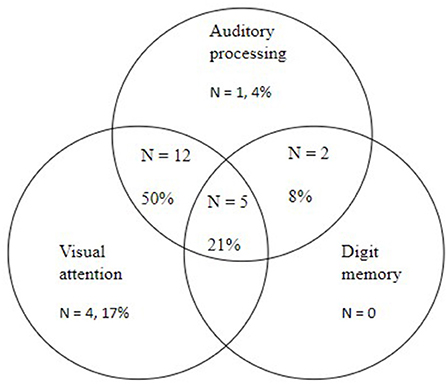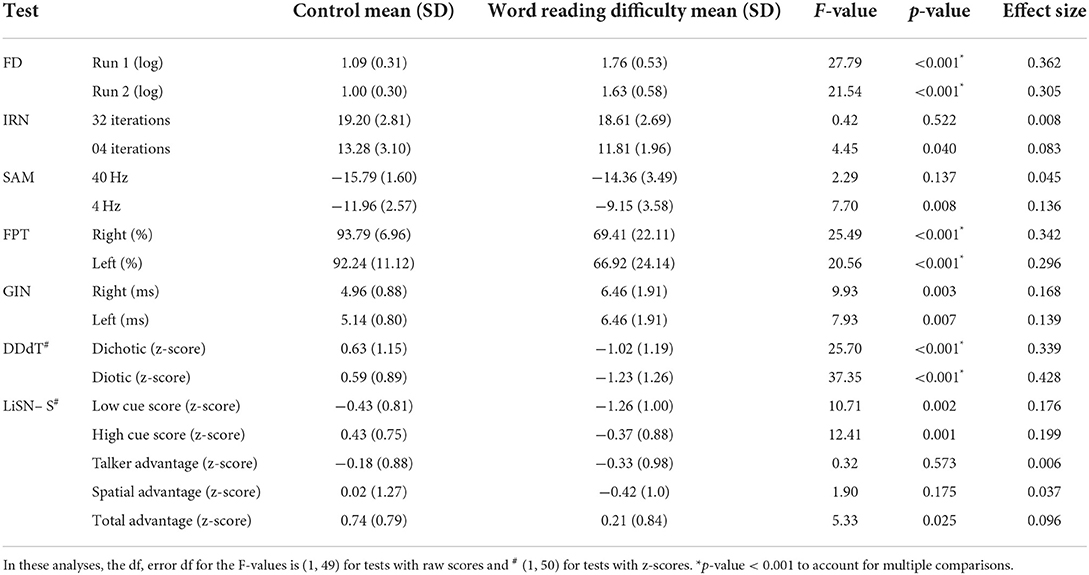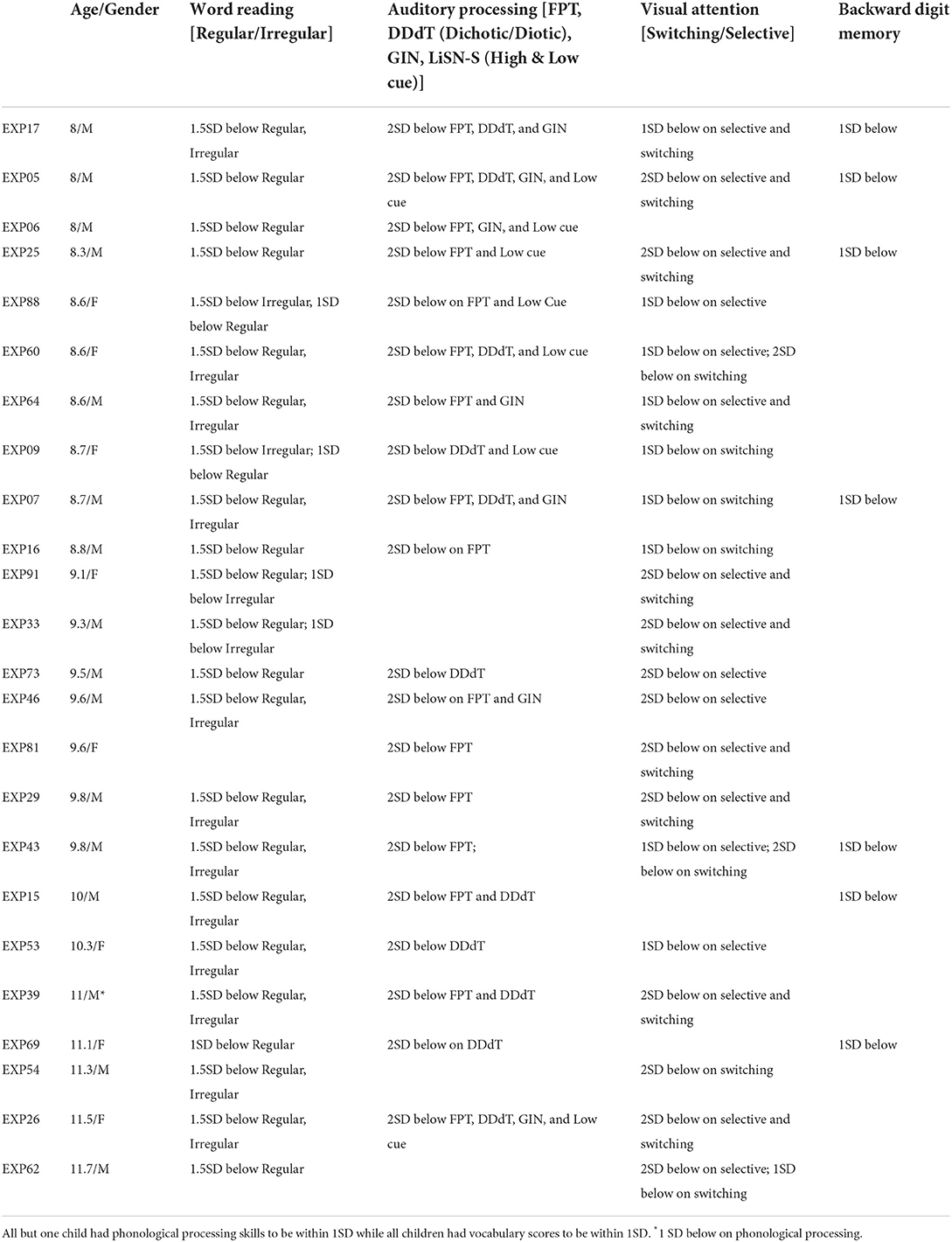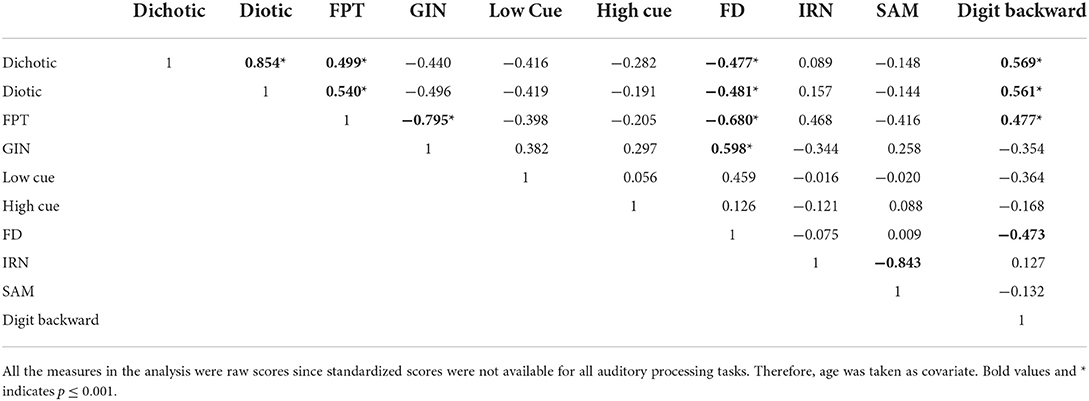- 1Department of Linguistics, Macquarie University, Sydney, NSW, Australia
- 2HEARing Cooperative Research Centre, Melbourne, VIC, Australia
- 3Centre for Language Sciences, Macquarie University, Sydney, NSW, Australia
- 4National Acoustic Laboratories, Sydney, NSW, Australia
A corrigendum on
Comorbidity of auditory processing, attention, and memory in children with word reading difficulties
by Gokula, R., Sharma, M., Cupples, L., and Valderrama, J. T. (2019). Front. Psychol. 10:2383. doi: 10.3389/fpsyg.2019.02383
In the published article, there were errors in several figures and tables, and their captions. Due to the removal of one participant, several amendments were required to the values stated. The corrected figures, tables, and captions are shown below.
Figure 2 and its corrected caption are shown below.

Figure 2. Venn diagram displaying the co-morbidities observed in the children (n = 24) with word reading difficulties in the current study.
Due to the removal of one participant, several corrections were also required to the text.
Corrections have been made to Abstract, sections Design and Results. The corrections are shown below.
Abstract, Design
This sentence previously stated: “Twenty-five children with word reading difficulties and 28 control children with good word reading skills participated.” The corrected sentence appears below:
“Twenty-four children with word reading difficulties and 28 control children with good word reading skills participated.”
Abstract, Results
This sentence previously stated “The results from children with word reading difficulties showed that 5 children (20%) had comorbid deficits in auditory processing, visual attention, and backward digit memory; whereas 12 children (48%) had comorbid auditory processing and visual attention deficits only.” The corrected sentence appears below:
“The results from children with word reading difficulties showed that 5 children (21%) had comorbid deficits in auditory processing, visual attention, and backward digit memory; whereas 12 children (50%) had comorbid auditory processing and visual attention deficits only.”
Corrections have been made to Materials and Methods, sections Participants and Inclusion Criteria.
Materials and Methods, Participants
This sentence previously stated: “Fifty-three children aged 8–11 years (Mean age in years ± SD = 9.7 ± 1.17) participated in the current study. Of the 53 children, 25 (9.5 ± 1.16 years) were identified as having reading concerns.” The corrected sentence appears below:
“Fifty-two children aged 8–11 years (Mean age in years ± SD = 9.8 ± 1.15) participated in the current study. Of the 52 children, 24 (9.5 ± 1.15 years) were identified as having reading concerns.”
Materials and Methods, Inclusion Criteria, Paragraph 6
This previously stated: “This table shows no significant difference for the audiometry thresholds obtained by children in the two groups from 500 to 4k Hz for both ears [F(3,153) = 1.64, p = 0.18]. The group mean audiometry result for the left and right ear is presented in Figure 1 that shows no significant difference for the extended high frequencies 8k to 12.5k Hz [F(4,204) = 0.35, p = 0.82]. The control group showed a small but significant advantage on the WNV when compared to the group with word reading difficulties [F(1,51) = 5.28, p = 0.03], but both groups scored around 1 SD above the mean on average (see Table 1).” The corrected paragraph appears below.

Table 1. Means (and SDs in parentheses) for age, PTA (0.5–4 kHz), and WNV scores for children in the two groups.
“Table 1 presents the means and SDs of children's age, PTA, and WNV scores according to group. This table shows no significant difference for the audiometry thresholds obtained by children in the two groups from 500 to 4k Hz for both ears [F(3, 147) = 0.29, p = 0.84]. The group mean audiometry result for the left and right ear is presented in Figure 1 that shows no significant difference for the extended high frequencies 8k to 12.5k Hz [F(4, 196) = 0.79, p = 0.54]. Both groups scored similarly and around 1 SD above the mean on average on WNV [F(1, 50) = 2.94, p = 0.09].”
Corrections have been made to several sections within Results.
Results, Tests of Reading and Phonological Processing
The paragraph previously stated: “By contrast, the group with word reading difficulties had mean z-scores of −1.9 (SD = 0.40), −1.4 (SD = 0.66), and −1.9 (SD = 0.40) respectively. Children in the control group achieved standard scores of 13.8 (SD = 1.20) on the phonological awareness test of elision while the children with word reading difficulties had an average standard score of 10.3 (SD = 2.65) with a statistically significant difference between the groups (F[1,51] = 45.0, p < 0.001).” The corrected text appears below.
“By contrast, the group with word reading difficulties had mean z-scores of −1.9 (SD = 0.42), −1.5 (SD = 0.56), and −1.9 (SD = 0.43) respectively. Children in the control group achieved standard scores of 13.8 (SD = 1.20) on the phonological awareness test of elision while the children with word reading difficulties had an average standard score of 10.3 (SD = 2.71) with a statistically significant difference between the groups [F(1, 50) = 38.9, p < 0.001].”
Results, Vocabulary, Visual attention, Digit memory, Paragraph 1
The sentence previously stated: “A univariate analysis of variance conducted on children's PPVT-4 standard scores showed that participants with word reading difficulty knew significantly fewer spoken word meanings (99.4 ± 7.9) than children in the control group (110.2 ± 9.3; F[1,51] = 19.3, p < 0.001).” The corrected sentence appears below.
“A univariate analysis of variance conducted on children's PPVT-4 standard scores showed that participants with word reading difficulty knew significantly fewer spoken word meanings (100.0 ± 7.88) than children in the control group [110.3 ± 9.3; F(1, 50) = 18.0, p < 0.001].”
Results, Vocabulary, Visual attention, Digit memory, Paragraph 2
The sentence previously stated “An additional two-way ANOVA confirmed the presence of a significant interaction between group and subtest [F(1,51) = 24.15, p < 0.001].” The corrected sentence appears below.
“An additional two-way ANOVA confirmed the presence of a significant interaction between group and subtest [F(1, 50) = 19.74, p < 0.001].”
Results, Subgroup Profiles, Paragraph 3
The paragraph previously stated: “Figure 2 and Table 5 show that, of the 25 children with word reading difficulties, 20% (n = 5) had comorbid deficits in three variables: auditory processing, visual attention, and digit memory. A larger percentage of children (56%, n = 14) had comorbid deficits in two variables: 12 children had auditory processing deficits and visual attention difficulties, and 2 had deficits in auditory processing and digit memory. No child experienced comorbid deficits in only visual attention and digit memory. Finally, six (24%) of the children with word reading difficulties displayed a comorbid deficit in just one other variable: four children had visual attention difficulties, one an auditory processing deficit, and one a deficit in digit memory. An alternative way of thinking about these subgrouping data is that 84% (n = 21) of this cohort of children with word reading difficulties had comorbid visual attention problems, and 80% had auditory processing deficits. Further detail regarding the specific deficits displayed by each child with non-word reading difficulties is presented in Table 5. This table presents the profiles of the 25 children with non-word reading deficits on word reading, auditory processing, attention, and digit memory. This table shows that, within the total cohort, children presented a tendency to have deficits on multiple auditory processing tasks (n = 13) or on both visual attention tasks of switching and selective (n = 11).” The corrected paragraph appears below.

Table 3. Univariate ANOVA results alongside the means (and standard deviations in parentheses) across the two groups for the individual auditory processing tests.

Table 4. Univariate ANOVA results alongside the means (and standard deviations in parentheses) across the two groups for the visual attention and working memory tests.

Table 5. Profiles of the 24 children with non-word reading deficits on word reading, auditory processing, attention, digit memory.
“Figure 2 and Table 5 show that, of the 24 children with word reading difficulties, 21% (n = 5) had comorbid deficits in three variables: auditory processing, visual attention, and digit memory. A larger percentage of children (58%, n = 14) had comorbid deficits in two variables: 12 children had auditory processing deficits and visual attention difficulties, and 2 had deficits in auditory processing and digit memory. No child experienced comorbid deficits in only visual attention and digit memory. Finally, six (25%) of the children with word reading difficulties displayed a comorbid deficit in just one other variable: 4 children had visual attention difficulties, and 1 an auditory processing deficit. An alternative way of thinking about these subgrouping data is that 88% (n = 21) of this cohort of children with word reading difficulties had comorbid visual attention problems, and 83% had auditory processing deficits. Further detail regarding the specific deficits displayed by each child with non-word reading difficulties is presented in Table 5. This table presents the profiles of the 24 children with nonword reading deficits on word reading, auditory processing, attention, and digit memory. This table shows that, within the total cohort, children presented a tendency to have deficits on multiple auditory processing tasks (n = 13) or on both visual attention tasks of switching and selective (n = 11).”
Results, Correlations Across Auditory Processing Tasks in Children With Word Reading Difficulties, Paragraph 1
The paragraph previously said, “Table 6 presents the Pearson's correlation coefficients between the auditory processing measures. With age taken as covariate, Pearson correlations showed that FPT was highly correlated to GIN (r = −0.70, p < 0.001) and FD (r = −0.79, p < 0.001) but not DDdT (r = 0.33, p = 0.10). The dichotic score was correlated to the diotic score though (r = 0.77, p < 0.001). There were no more significant correlations between any of the other auditory processing measures. Furthermore, digit backwards scores were also not significantly correlated with any auditory processing measures (p's > 0.05).”

Table 7. Pearson correlation for word reading, visual attention, receptive vocabulary, and the phonological processing measure of elision. Standardized scores were used in the analysis.
The corrected paragraph appears below.
“Table 6 presents the Pearson's correlation coefficients between the auditory processing measures. With age taken as covariate, Pearson correlations showed that FPT was highly correlated to GIN (r = −0.75, p < 0.001) and FD (r = −0.73, p < 0.001) but not to combined score of DDdT (r = −0.19, p = 0.19). The dichotic score was correlated to the diotic score (r = 0.85, p < 0.001). Digit backwards scores were significantly correlated to FPT, and FD (p's ≤ 0.001).”
Results, Correlations Across Auditory Processing Tasks in Children With Word Reading Difficulties, Paragraph 2
The sentence previously said, “This table shows no significant correlation between selective attention and attention switching (r = 0.29, p = 0.21). This table also shows that none of the word reading measures were correlated with visual attention, receptive vocabulary, or elision (p's > 0.05) Irregular word reading was, however, significantly correlated with regular word reading (r = 0.655, p < 0.001).” The corrected sentence appears below.
“This table shows significant correlation between selective attention and attention switching (r = 0.49, p < 0.001). This table also shows that the word reading measures were significantly correlated to each other and to switching attention, receptive vocabulary, and elision (p ≤ 0.001).”
Corrections have also been made to section Discussion
Discussion, Paragraph 3
The sentence previously said, “For instance, none of the children would be regarded as having a digit memory deficit, and only 14 (56%) children would be considered to have visual attention deficits compared to the current 21 (84%).” The corrected sentence appears below.
“For instance, none of the children would be regarded as having a digit memory deficit, and only 14 (58%) children would be considered to have visual attention deficits compared to the current 21 (88%).”
Discussion, Comorbidities in Children With Word Reading Difficulties, Paragraph 2
The sentence previously said, “However, this suggestion does not appear to hold true for the current cohort in which 4 out of 21 children with an attention deficit showed evidence of no other deficit, and a further 4 children showed evidence of deficits in auditory processing and/or digit memory, despite having no attention deficit. Furthermore, all except one of the 25 children with reading difficulties, including those with visual attention deficits, performed within 1 SD of the typical mean on both phonological processing (elision) and receptive vocabulary.” The corrected sentence appears below.
“However, this suggestion does not appear to hold true for the current cohort in which 4 out of 21 children with an attention deficit showed evidence of no other deficit, and a further 3 children showed evidence of deficits in digit memory and/or auditory processing, despite having no attention deficit. Furthermore, all except one of the 24 children with reading difficulties, including those with visual attention deficits, performed within 1SD of the typical mean on both phonological processing (elision) and receptive vocabulary.”
Discussion, Auditory Processing Skills in Children With Word Reading Difficulty, Paragraph 4
The sentence previously said, “At the same time, most of the children with word reading difficulties (n = 7, 32%) had both FPT and DDdT deficits.” The corrected sentence appears below.
“At the same time, only a third of the children with word reading difficulties (n = 7, 29%) had both FPT and DDdT deficits.”
Discussion, Auditory Processing Skills in Children With Word Reading Difficulty, Paragraph 7
The sentence previously said, “In the current study, a cohort of 25 children with non-word reading difficulties participated.” The corrected sentence appears below.
“In the current study, a cohort of 24 children with non-reading word difficulties participated.”
Corrections have also been made to section Conclusion
The sentence previously said, “On the standardized tests of auditory processing (FPT, DDdT, LiSN-S, GIN), 80% of children with non-word reading difficulties showed a significant deficit.” The corrected sentence appears below.
“On the standardized tests of auditory processing (FPT, DDdT, LiSN-S, GIN), 83% of children with non-word reading difficulties showed a significant deficit.”
The authors apologize for these errors and state that they do not change the scientific conclusions of the article in any way. The original article has been updated.
Publisher's note
All claims expressed in this article are solely those of the authors and do not necessarily represent those of their affiliated organizations, or those of the publisher, the editors and the reviewers. Any product that may be evaluated in this article, or claim that may be made by its manufacturer, is not guaranteed or endorsed by the publisher.
Keywords: word reading difficulty, auditory processing, cognition, digit memory, receptive language
Citation: Gokula R, Sharma M, Cupples L and Valderrama JT (2022) Corrigendum: Comorbidity of auditory processing, attention, and memory in children with word reading difficulties. Front. Psychol. 13:1048163. doi: 10.3389/fpsyg.2022.1048163
Received: 19 September 2022; Accepted: 14 October 2022;
Published: 17 November 2022.
Edited and reviewed by: Eliane Schochat, University of São Paulo, Brazil
Copyright © 2022 Gokula, Sharma, Cupples and Valderrama. This is an open-access article distributed under the terms of the Creative Commons Attribution License (CC BY). The use, distribution or reproduction in other forums is permitted, provided the original author(s) and the copyright owner(s) are credited and that the original publication in this journal is cited, in accordance with accepted academic practice. No use, distribution or reproduction is permitted which does not comply with these terms.
*Correspondence: Rakshita Gokula, cmFrc2hpdGEuZ29rdWxhQGdtYWlsLmNvbQ==
 Rakshita Gokula
Rakshita Gokula Mridula Sharma
Mridula Sharma Linda Cupples
Linda Cupples Joaquin T. Valderrama
Joaquin T. Valderrama